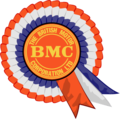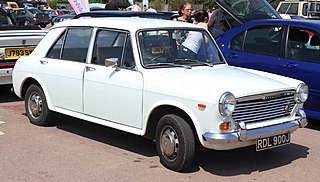
The Mini is a two-door compact city car that was produced by the British Motor Corporation (BMC) and its successors from 1959 until 2000. The original Mini is considered an icon of 1960s British popular culture. Its space-saving transverse engine and front-wheel drive layout – allowing 80% of the area of the car's floorpan to be used for passengers and luggage – influenced a generation of car makers. In 1999, the Mini was voted the second-most influential car of the 20th century, behind the Ford Model T, and ahead of the Citroën DS and Volkswagen Beetle. The front-wheel-drive, transverse-engine layout of the Mini was copied for other "supermini" designs including the Honda N360 (1967), Nissan Cherry (1970), and Fiat 127 (1971). The layout was also adapted for larger subcompact designs.

Morris Motors Limited was a British privately owned motor vehicle manufacturing company formed in 1919 to take over the assets of William Morris's WRM Motors Limited and continue production of the same vehicles. By 1926 its production represented 42 per cent of British car manufacture—a remarkable expansion rate attributed to William Morris's practice of buying in major as well as minor components and assembling them in his own factory. Self-financing through his enormous profits Morris did borrow some money from the public in 1926 and later shared some of Morris Motors' ownership with the public in 1936 when the new capital was used by Morris Motors to buy many of his other privately held businesses.

The British Motor Corporation Limited (BMC) was a UK-based vehicle manufacturer, formed in early 1952 to give effect to an agreed merger of the Morris and Austin businesses.

The Morris Marina is a front-engined, rear-wheel-drive small family car that was manufactured by the Austin-Morris division of British Leyland from 1971 until 1980. It served to replace the Morris Minor in the Morris product line, which had first been built in 1948. The Marina was also sold in some markets as the Austin Marina, the Leyland Marina and the Morris 1700.

The Austin Motor Company Limited was a British manufacturer of motor vehicles, founded in 1905 by Herbert Austin. In 1952 it was merged with Morris Motors Limited in the new holding company British Motor Corporation (BMC) Limited, keeping its separate identity. The marque Austin was used until 1987. The trademark is currently owned by the Chinese firm SAIC Motor, after being transferred from bankrupt subsidiary Nanjing Automotive which had acquired it with MG Rover Group in July 2005.

British Leyland was an automotive engineering and manufacturing conglomerate formed in the United Kingdom in 1968 as British Leyland Motor Corporation Ltd (BLMC), following the merger of Leyland Motors and British Motor Holdings. It was partly nationalised in 1975, when the UK government created a holding company called British Leyland, later renamed BL in 1978. It incorporated much of the British-owned motor vehicle industry, which in 1968 had a 40 percent share of the UK car market, with its history going back to 1895.
British Motor Holdings Limited (BMH) was a British vehicle manufacturing company known until 14 December 1966 as British Motor Corporation Limited (BMC). BMH was created as a holding company following the BMC's takeover of both Jaguar Cars and the Pressed Steel Company in that year.

The Austin Princess is a series of large luxury cars that were made by Austin and its subsidiary Vanden Plas from 1947 to 1968. The cars were also marketed under the Princess and Vanden Plas marque names.

Leyland Motors Limited was a British vehicle manufacturer of lorries, buses and trolleybuses. The company diversified into car manufacturing with its acquisitions of Triumph and Rover in 1960 and 1967, respectively. It gave its name to the British Leyland Motor Corporation, formed when it merged with British Motor Holdings in 1968, to become British Leyland after being nationalised. British Leyland later changed its name to simply BL, then in 1986 to Rover Group.

The Morris Minor is a British economy family car that made its debut at the Earls Court Motor Show, London, on 20 September 1948. Designed under the leadership of Alec Issigonis, more than 1.6 million were manufactured between 1948 and 1972 in three series: the MM, the Series II, and the 1000 series.

The Triumph 1300 is a medium/small 4-door saloon car that was made between 1965 and 1970 by Standard Triumph in Coventry, England, under the control of Leyland Motors. It was introduced at the London Motor Show in October 1965 and intended as a replacement for the popular Triumph Herald. Its body was designed by Michelotti in a style similar to the larger Triumph 2000. It was replaced by the Triumph 1500, though it was also re-engineered in the early 1970s to provide the basis for the Toledo and Dolomite ranges.

BMC ADO17 is the model code used by the British Motor Corporation (BMC) for a range of large family cars manufactured from September 1964 to 1975. The car was initially sold under the Austin marque as the Austin 1800, then by Morris as the Morris 1800, by Wolseley as the Wolseley 18/85, and later the Austin 2200, Morris 2200 and Wolseley Six. The 1800 was voted European Car of the Year for 1965.

The BMC ADO16 is a range of small family cars built by the British Motor Corporation (BMC) and, later, British Leyland. Launched in 1962, it was Britain's best-selling car from 1963 to 1966 and from 1968 to 1971. The ADO16 was marketed under various make and model names; however, the Austin 1100 and Morris 1100 were the most prolific of all the ADO16 variants.
The Austin Cambridge is a motor car range produced by the Austin Motor Company, in several generations, from September 1954 through to 1971 as cars and to 1973 as light commercials. It replaced the A40 Somerset and was entirely new, with modern unibody construction. The range had two basic body styles with the A40, A50, and early A55 using a traditional rounded shape and later A55 Mark IIs and A60s using Pininfarina styling.

The Mark I Mini (1959–1967) was the first version of British Motor Corporation's Mini. It is characterised by its sliding windows, external door hinges and "moustache" grille. In the United Kingdom the Mark I was produced between 1959 and 1967, with production in Australia continuing until 1970. The Mini Mark I was sold under both Austin and Morris marque names.

The Austin 3-Litre is a British saloon car that was introduced by Austin at the London Motor Show in 1967. It became apparent that BMC were not geared up to producing the car: few or none seem to have been sold that year, but by July 1968, it was reported that the cars had begun to leave the factory. By that time, the square headlights seen at the 1967 motor show had been replaced by conventional round twin headlamp units, and by the time of the October 1968 show the car had also acquired front quarter lights. In July 1968, with cars beginning to emerge from the plant, the manufacturers were asked to detail improvements reportedly implemented since the car's "launch" the previous October. Mention was made of orifice modifications to hydraulic valves in the rear suspension, and it was stated that there was a "new" final drive ratio of 3.9:1, though this was actually the same final drive ratio included in the launch information the previous October.

BMC is one of the largest commercial and military vehicle manufacturers in Turkey. Its products include commercial trucks, buses, military trucks and armoured vehicles. The company was founded in 1964 with 26% partnership of UK's British Motor Corporation. It was taken over by Çukurova Holding of Turkey in 1989, and seized by the Turkish government's TMSF in 2013. BMC has been taken over with a final bid of TL 751M, by a partnership of 51% Turkish side and 49% Qatari side.

Morris Commercial Cars Limited was a British manufacturer of commercial vehicles formed by William Morris, founder of Morris Motors Limited, to continue the business of E G Wrigley and Company which he purchased as of 1 January 1924.

The Morris Commercial J4 was a 10 cwt forward-control van launched by Morris Commercial in 1960 and produced with two facelifts until 1974.

The Standard Atlas is a light van which was produced and sold under various names between 1958 and 1980, initially in Britain and Europe, and subsequently in India.

















